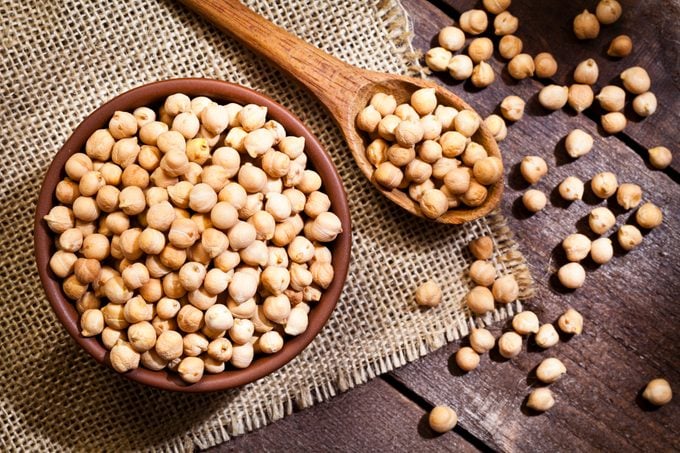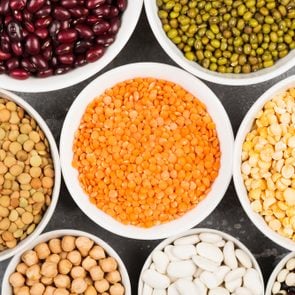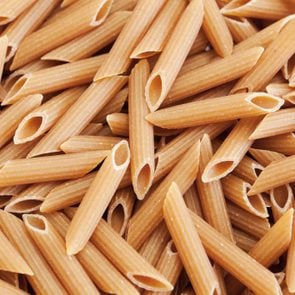6 Chickpea Nutrition Facts You Should Know
Updated: Apr. 05, 2021
Love chickpeas? Find out more about the nutrition and health benefits of this versatile legume that can be used to make salads, hummus, chickpea pasta, chickpea flour, and more.
Chickpeas are healthy
To eat hummus is to love it. And since the snack is made of chickpeas, loving hummus means embracing the nutritional value of this versatile legume, which is technically a pulse, or a dried, edible seed like lentils, peas, and beans.
In addition to hummus, chickpeas can be added to salads and other recipes, used to make chickpea flour, chickpea pasta, roasted for a snack, and more. (Check out these chickpea snacks nutritionists love.)
“They are a low-cost source of plant-based protein, fiber, antioxidants, and a slew of vitamins and minerals,” says Lauren Manaker, MS, RDN, author of Fueling Male Fertility. “Incorporating them into a healthy lifestyle can help support overall health.”
We chatted with top health experts to get the scoop on all things chickpeas. Read on to learn the fun facts about this legume.

Fact: Chickpeas are an ancient food
Also known as the garbanzo bean and the ceci bean, the chickpea grows in subtropical and temperate regions. One of the first-cultivated vegetables on this planet, chickpeas likely first grew in Mesopotamia as many as 7,500 years ago.
A member of a family of flowering plants, the chickpea plant—called Cicer arietinum—contains seedpods that hold up to three chickpeas. The chickpea has a firm texture and a mild, nutty flavor. There are two main varieties: the Desi and the Kabuli.
Desi chickpeas have small, dark seeds with a rough coat. These come mostly from India, Ethiopia, Mexico, and Iran. Desi chickpeas are consumed heavily in India.
The Kabuli, on the other hand, is a lighter-colored, larger seed with a smoother coat. These are grown primarily in Europe, Africa, Afghanistan, and Chile. Kabuli chickpeas are more common in North America and are often sold as canned chickpeas, dry chickpeas, or hummus. The information that follows highlights the Kabuli chickpea.
Fact: Chickpeas are full of nutrients
Although you can, of course, prepare dry chickpeas, the canned variety makes consuming the nutrient-rich food incredibly easy. “Chickpeas can be categorized as both a vegetable and a protein, making it an incredibly versatile food choice,” says Manaker. (See top plant-based food trends for 2021.)
Canned chickpeas may contain added salt. To avoid, simply look for “low-sodium” on the label. Hummus is minimally processed and as a baseline typically includes tahini, oil, and spices in addition to chickpeas.
Per one cup cooked chickpeas, you get 269 calories, 15 grams protein, 4 grams fat, 45 grams carbohydrates, 13 grams fiber, and a variety of vitamins and minerals.
Fact: Chickpeas boast good-for-you fiber
Chickpeas are an excellent source of fiber, which can be beneficial for satiety, cholesterol, and gut health. “Chickpeas contain both soluble and insoluble fiber,” says Manaker. This means that the fiber helps digestive health not only by helping to bulk up stool, but also to get things moving and help prevent constipation.
“The soluble fiber binds LDL ‘bad’ cholesterol in your digestive system and removes it from the body through waste before it’s absorbed,” says Beth Stark, RDN, a culinary dietitian in Harrisburg, Pennsylvania. “This helps combat the buildup of such cholesterol in your arteries and ultimately lowers risk for heart attack, stroke, and high blood pressure.”
Foods rich in protein and fiber—such as chickpeas—help keep you full for longer, which can help with weight control. (Take a look at the Mediterranean foods you should always have on hand.)
Fact: Chickpeas offer healthy fats
Fiber isn’t the only nutrient in chickpeas that helps your ticker. “Chickpeas contain polyunsaturated fatty acids, which have been shown to support heart health,” says Manaker.
Additionally, chickpeas are a source of plant-based alpha-linolenic acid (ALA), a type of omega-3 fatty acid that “can help raise HDL cholesterol levels, known as ‘good cholesterol,’ ” says Stark. “This can help lower both triglycerides and blood pressure when included in an eating pattern that’s otherwise heart healthy.”
Plus, chickpeas can be included in so many eating styles. “They are a food that can be enjoyed as part of various therapeutic or health-promoting diets such as heart-healthy, diabetes-friendly, gluten-free, plant-based, vegetarian, vegan, and Mediterranean, to name a few,” says Manaker.
Fact: Chickpeas contain many minerals
The legume is an excellent source of folate, zinc, copper, iron, and manganese. “Eating chickpeas during pregnancy can help a (woman) meet her folate needs, which in turn can reduce the risk of the baby developing birth defects like spina bifida,” says Manaker.
Zinc is a mineral that’s important for development of some of the cells in charge of defending your body against toxins or foreign substances that threaten your immunity. Copper and iron work together to help your body form red blood cells, and manganese is helpful for blood sugar control.
(See what other pantry staples dietitians recommend you have on hand.)
Fact: The ways to enjoy chickpeas are endless
Now that we’ve gone over the many health benefits of chickpeas, how about some nutritious, delicious ideas to prepare them?
“With their hearty texture and slightly nutty flavor, chickpeas can be added to almost any meal with ease,” says Stark. “A favorite is using them in a plant-based Mediterranean-inspired grain bowl with roasted tomatoes and cauliflower, torn kale, kalamata olives, feta cheese, and a dollop of hummus.”
You can also toss them into a smoothie or chopped salad. In fact, roasted chickpeas are a great addition to salads in lieu of croutons. “I also love to use crispy roasted chickpeas as a garnish for homemade pureed soups like creamy tomato or butternut squash,” says Stark. Ready for dessert? Blend chickpeas into a vegan cookie dough.
Next up: Get more nutritious canned bean recipes.
Sources
- USA Pulses: “Chickpeas”
- New World Encyclopedia: “Chickpea”
- Lauren Manaker, MS, RDN, author of Fueling Male Fertility
- USDA FoodData Central: “Chickpeas (garbanzo beans, bengal gram), mature seeds, cooked, boiled, without salt”
- Beth Stark, RDN, a culinary dietitian in Harrisburg, Pennsylvania
- American Heart Association: “Polyunsaturated Fat”




















